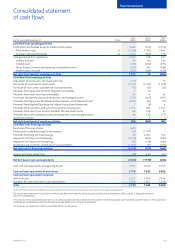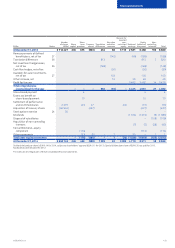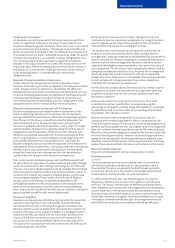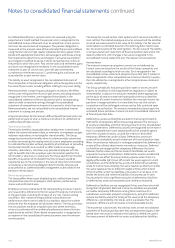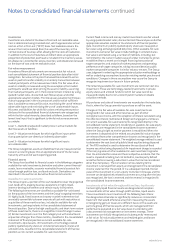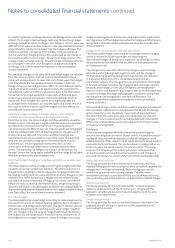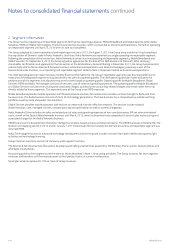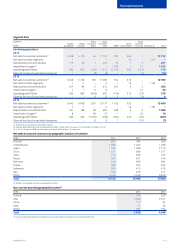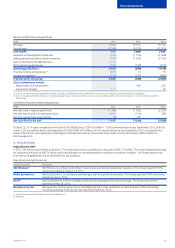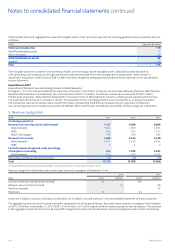Nokia 2014 Annual Report Download - page 137
Download and view the complete annual report
Please find page 137 of the 2014 Nokia annual report below. You can navigate through the pages in the report by either clicking on the pages listed below, or by using the keyword search tool below to find specific information within the annual report.
135
Financial statements
NOKIA IN 2014
Loans receivable
Loans receivable include loans to customers and suppliers and are
measured initially at fair value and subsequently at amortized cost
less impairment using the eective interest method. Loans are subject
to regular review as to their collectability and available collateral.
An allowance is made if a loan is deemed not to be fully recoverable.
The related cost is recognized in other expenses or nancial expenses,
depending on the nature of the receivable to reect the shortfall
between the carrying amount and the present value of the expected
future cash ows. Interest income on loans receivable is recognized
in other income or nancial income by applying the eective
interest rate.
Bank and cash
Cash consists of cash at bank and in hand.
Accounts receivable
Accounts receivable include both amounts invoiced to customers and
amounts where the Group’s revenue recognition criteria have been
fullled but the customers have not yet been invoiced. Accounts
receivable are carried at the original amount invoiced to customers
less allowances for doubtful accounts. Allowances for doubtful
accounts are based on a periodic review of all outstanding amounts,
including an analysis of historical bad debt, customer concentrations,
customer creditworthiness, past due amounts, current economic
trends and changes in customer payment terms. Impairment charges
on receivables identied as uncollectible are included in other
operating expenses. The Group derecognizes an accounts receivable
balance only when the contractual rights to the cash ows from the
asset expire or it transfers the nancial asset and substantially all the
risks and rewards of the asset to another entity.
Financial liabilities
The Group has classied its nancial liabilities into the following
categories: derivative and other current nancial liabilities, compound
nancial instruments, loans payable, and accounts payable. Derivatives
are described in the section on derivative nancial instruments.
Compound nancial instruments
Compound nancial instruments have both a nancial liability and an
equity component from the issuers’ perspective. The components are
dened based on the terms of the nancial instrument and presented
and measured separately according to their substance. The nancial
liability component is initially recognized at fair value, the residual
being allocated to the equity component. The allocation remains the
same for the life of the compound nancial instrument. The Group
has issued convertible bonds for which the nancial liability
component is accounted for as a loan payable.
Loans payable
Loans payable are recognized initially at fair value net of transaction
costs. In subsequent periods, loans payable are presented at
amortized cost using the eective interest method. Transaction costs
and loan interest are recognized in the consolidated income statement
as nancial expenses over the life of the instrument.
Accounts payable
Accounts payable are carried at invoiced amount which is considered
to be the fair value due to the short-term nature of the Group’s
accounts payable.
Derivative nancial instruments
All derivatives are recognized initially at fair value on the date a
derivative contract is entered into and subsequently remeasured at
fair value. The method of recognizing the resulting gain or loss varies
according to whether the derivatives are designated and qualify under
hedge accounting. Generally, the cash ows of a hedge are classied
as cash ows from operating activities in the consolidated statement
of cash ows as the underlying hedged items relate to the Group’s
operating activities. When a derivative contract is accounted for as
a hedge of an identiable position relating to nancing or investing
activities, the cash ows of the contract are classied in the same
way as the cash ows of the position being hedged.
Derivatives not designated in hedge accounting relationships
carried at fair value through prot and loss
Forward foreign exchange contracts are valued at market forward
exchange rates. Changes in fair value are measured by comparing
these rates with the original contract forward rate. Currency options
are valued at each statement of nancial position date by using the
Garman & Kohlhagen option valuation model. Changes in fair value
are recognized in the consolidated income statement.
Fair values of forward rate agreements, interest rate options, futures
contracts and exchange traded options are calculated based on
quoted market rates at each statement of nancial position date.
Discounted cash ow analyses are used to value interest rate and
cross-currency interest rate swaps. Changes in fair value are
recognized in the consolidated income statement.
For derivatives not designated under hedge accounting but
hedging identiable exposures such as anticipated foreign currency
denominated sales and purchases, the gains and losses are recognized
in other income or expenses. The gains and losses on all other
derivatives not designated under hedge accounting are recognized
in nancial income and expenses.
Embedded derivatives, if any, are identied and monitored by the
Group and measured at fair value at each consolidated statement
of nancial position date with changes in fair value recognized in the
consolidated income statement.
Hedge accounting
The Group applies hedge accounting on certain forward foreign
exchange contracts, certain options or option strategies, and certain
interest rate derivatives. Qualifying options and option strategies have
zero net premium or a net premium paid. For option structures, the
critical terms of the bought and sold options are the same and the
nominal amount of the sold option component is no greater than
that of the bought option.
Cash ow hedges: hedging of forecast foreign currency
denominated sales and purchases
The Group applies hedge accounting for ‘qualifying hedges’. Qualifying
hedges are those properly documented cash ow hedges of foreign
exchange rate risk of future forecast foreign currency denominated
sales and purchases that meet the requirements set out in IAS 39,
Financial Instruments: Recognition and Measurement. The hedged
item must be ‘highly probable’ and present an exposure to variations
in cash ows that could ultimately aect prot or loss. The hedge must
be highly eective, both prospectively and retrospectively.




